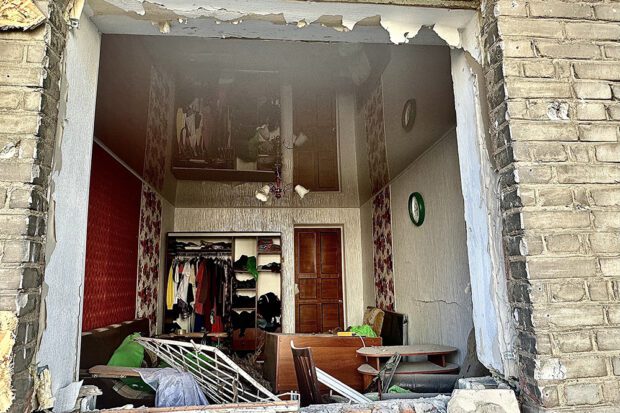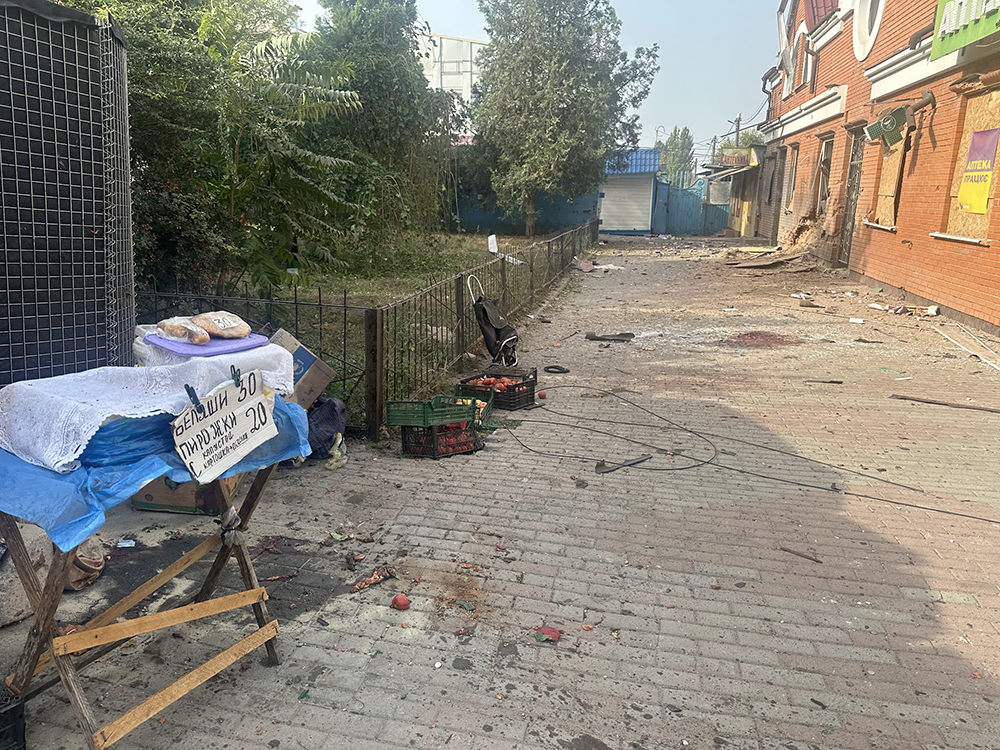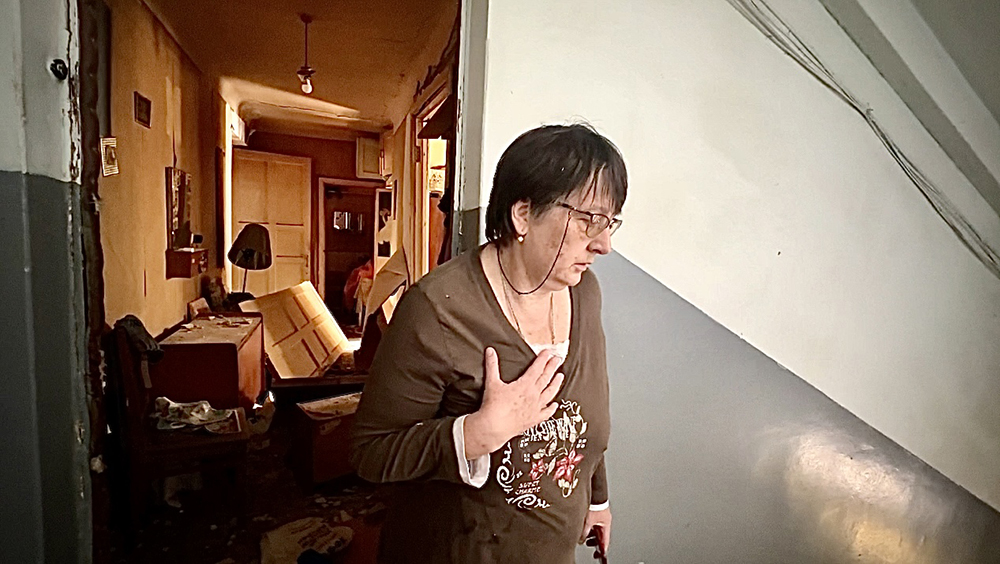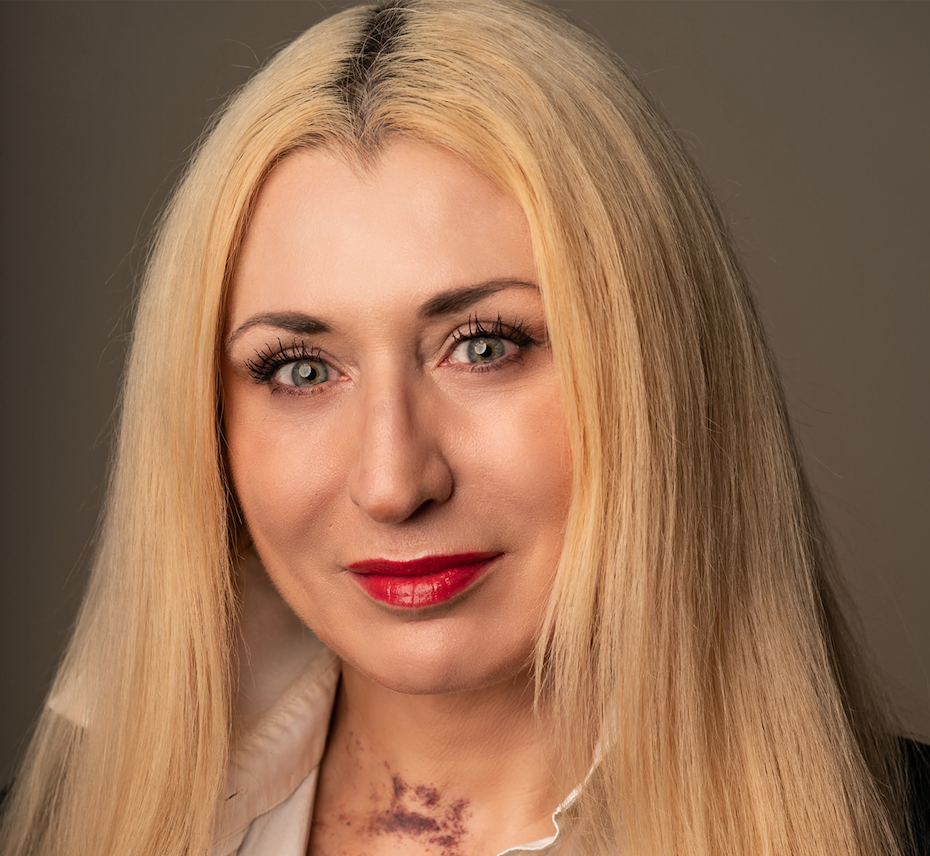
On Oct. 7, four aerial bombs struck residential areas in the city of Kherson in Southern Ukraine, injuring 20 civilians, including two children, two and four years old.
At one of the sites, across the street from the remains of a school destroyed by the bomb, a woman in her 70s was climbing the stairs to the third floor, on crutches. Breathing heavily, she stopped to wipe tears. She had just returned from a hospital visit to her son, who had been injured by a drone attack.
“He lost his arm and an eye,” she said. “I was just bringing him lunch when I heard the explosions—the walls of the hospital shook.”
As she rushed back home by a taxi, evading Russian drone attacks, she got a phone call from her daughter. The aerial bomb had hit their building.
The door was blown off the doorframe. Inside, the daughter was sifting through gray-dust covered trash, everything that remained of the family’s furniture and clothes, searching for documents.
Their neighbor, Olena, a handicapped woman in her late 60s, couldn’t make it up to her seventh-floor apartment without an elevator. She had gone out to buy some bread and potatoes and had hidden inside the supermarket during the bombing. When Olena returned, she asked a volunteer covering broken windows with plywood to take her groceries to her apartment.
“There isn’t much left of your apartment,” said the volunteer.
“My parrot is there,” said Olena. “I need to get there somehow.”
Like many, Olena suffered an acute reaction to stress and her mind refused to register the loss of her place. The volunteers ended up taking her grocery bags up, just to calm her down.
Her pet parrot, a cockatiel, had survived, though its cage had been thrown to the floor by the shockwave. The bird, a pale yellow face with bright red-orange cheeks, whistled happily at the sight of people. Soon, both the groceries and the parrot traveled down to the first floor where Olena and all the neighbors stood, waiting for help.

“The Russian Federation once again shelled the residential areas of the Kherson city,” said Olga Maliarchuk, deputy head of the Kherson Regional Administration. “Sadly, we are dealing with the aftermath.
“We have mobilized all experts to help and assist the affected people. I wish the whole world could see what is happening in Kherson and how people are surviving in such conditions.
“Guided aerial bombs attacks on civilians are the lowest of the low. Moreover, we are constantly targeted with artillery, mortars and tanks. They are also using drones to hunt civilians…this is like a game for them. It is terrifying.”
Across the lane, piles of concrete rubble lay in front of the ruined school, mixed with homework assignments, children’s drawings and pigeons killed by the shockwave. The school had not been operational since the Russian full-scale invasion on Feb. 24. Most children in Kherson had spent the last five years studying online—first due to Covid-19 and later because of the Russian occupation and the following shelling.
City authorities are now attempting to build underground schools, but the construction sites are frequently targeted by Russian forces. Many residents oppose the idea, as they’ve already lost their homes, and some have been killed or injured during these attacks.
“How are we supposed to get our children to school when drones hunt cars and pedestrians in the streets?” asked one resident of the bomb-damaged high-rise.
Just a few days earlier, on Sept. 25, a Russian aerial bomb had severely damaged a large community cultural and arts center, a staple of Kherson life.
“I used to take piano lessons there,” said Alyona, a dentist in her late 20s, tears in her eyes. “It felt like home to me.”
Elena Zvyagina, the former director of the center, cried during a telephone interview as she recalled what they had once called “a palace of culture.”

“We held dance competitions on the stage every year,” she said. “Rock concerts, theater shows, ballet classes and clubs for kids and families. During the first days of the Russian invasion, we sheltered the injured there and lived in the building. We even ran a soup kitchen for those in need.”
Later, she wrote on the center’s Facebook page, “while the building is destroyed, the Palace of Youth and Students is not only the walls and the roof! The Palace was, is and will definitely live! Together with all of you, as well as with those who will join our creative life after the Victory!”
After losing her husband, Elena had to relocate her elderly parents away from Kherson. Many others are also leaving.
At another four-story building, a family of three was preparing to move out when the bomb struck on Oct. 7. The mother had gone to wash her hands while the children were finishing their breakfast of eggs and bread in the kitchen.
“We were lucky to survive,” said Nataliia. “Even our cats and dog made it.”
Pets and street animals are an important part of the city life and suffer from the attacks as much as humans. Outside, a severely burnt crow was dying, with its mate next to it. Crows mate for life.
Inside, a cat, confused by the blast, sat on the steps. Its owner, Masha, had stepped out to the market, and her daughter was at work, but Nataliia could not find their other cat, missing among the mix of beams, ceilings and door frames that had been their apartment.
Although going to the market saved one woman’s life, it remains a dangerous activity in Kherson. On Sept. 30, six civilians were killed and six more were injured at the Central Market. A woman selling pirozhki at the corner and several men opening their stalls near the drugstore were killed instantly by artillery fire. Police and paramedics arrived to retrieve the bodies and rescue the wounded, risking their lives as Russian military drones often target first responders at disaster sites.
Being evacuated to a hospital doesn’t guarantee safety, either. Russian forces deliberately target healthcare facilities, killing doctors and patients with drones. In September, Volodymyr Terelyuk, a well-known doctor from the Oncology Center—who had stayed in Kherson to save lives—was killed by a drone while driving to work. His wife, in the car with him, was injured.
Despite the danger, the hospitals remain full. On Oct. 8, while our crew interviewed four elderly men wounded by drones, five more residents arrived at the ER needing urgent surgery. Doctors use magnetic devices to remove shrapnel from victims’ bodies.
However, the Russian military sometimes uses titanium-alloy shrapnel that’s too light to be extracted with magnets, leaving victims to live with pieces of homemade drone grenades lodged inside them. One of them, Anastasiia, a 23-year-old mother of two, was biking home from work when a drone dropped a grenade on her. Russian social media channels later published drone footage of her on her bicycle, falsely claiming she was a “Ukrainian soldier.”
This practice of publicizing attacks has become routine, often accompanied by pop music. The drones, referred to as “birdies,” are shown targeting civilians and all cars near the Dnipro River.
Drones attacked bicyclists almost weekly in October, making movement around the city and suburbs increasingly perilous. Cars and buses are targeted daily. Pedestrians dart from tree to tree on their way to grocery stores, but many fall victim to drone attacks.
As the leaves fall and winter approaches, the natural shelter provided by trees disappears. In the first two weeks of October, 1,396 drone attacks were reported in Kherson, according to Oleksandr Tolokonnikov, spokesperson for the regional military administration. From Oct. 1 to 14, there were 63 civilian casualties, with eight fatalities; 55 were injured, including two children.
While drones hunt civilians and drop banned anti-personnel mines and napalm-like substances on residential rooftops, artillery strikes and aerial bombings continue to escalate. Critical infrastructure is being systematically destroyed, with daily reports of gas pipelines and power stations being hit. In just one week in October, two postal offices were heavily damaged. Humanitarian aid deliveries have also become nearly impossible, as volunteer vehicles are frequently targeted.
Yet, Khersonians continue to display remarkable resilience and determination. In August, a small cultural center opened underground. One room serves as a library, packed with Ukrainian books for children and adults. An art gallery showcasing modern art and folk costumes occupies another space. In an adjoining workshop, eight women weave camouflage nets for the military.
“I live by the river and come here every day,” said one of the women. “We must help our army defend us. We believe in victory. Kherson is Ukraine.”

